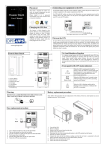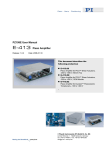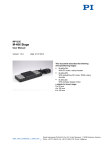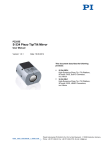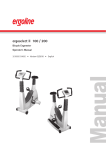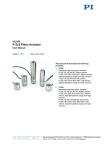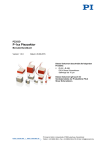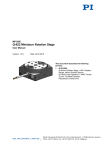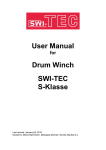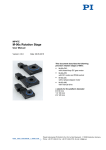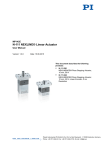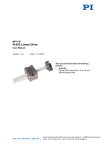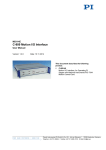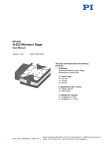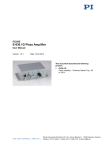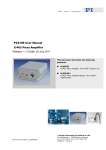Download User Manual PZ252E
Transcript
PZ252E P-1xx Piezo Actuator User Manual Version: 1.0.0 Date: 29.06.2015 This document describes the following products: P-111 - P-151 PICA Shear Actuators Travel ranges up to 10 µm This document also applies to custom products from the PICA Shear Actuator product line. PI Ceramic GmbH, Lindenstrasse, 07589 Lederhose, Germany Phone: +49 36604 882-0, Fax: +49 36604 882-4109, Email: [email protected] Physik Instrumente (PI) GmbH & Co. KG is the owner of the following trademarks: PI®, PIC®, PICMA®, PILine®, PIFOC®, PiezoWalk®, NEXACT®, NEXLINE®, NanoCube®, NanoAutomation®, Picoactuator®, PInano® © 2015 PI Ceramic GmbH, Lederhose, Germany. The text, photographs and drawings in this manual are protected by copyright. With regard thereto, PI Ceramic GmbH retains all the rights. Use of said text, photographs and drawings is permitted only in part and only upon citation of the source. Original instructions First printing: 29.06.2015 Document number: PZ252E, CBo, Version 1.0.0 Subject to change without notice. This manual is superseded by any new release. The latest release is available for download (p. 3) on our website. Contents 1 About this Document 1.1 1.2 1.3 1.4 1.5 1.6 2 3 Objective and Target Audience of this User Manual ............................................1 Validity for Custom Products ................................................................................1 Symbols and Typographic Conventions ...............................................................2 Figures ..................................................................................................................3 Other Applicable Documents ................................................................................3 Downloading Manuals ..........................................................................................3 Safety 2.1 2.2 2.3 5 Intended Use ........................................................................................................5 General Safety Instructions ..................................................................................6 Organizational Measures ......................................................................................7 Product Description 3.1 3.2 3.3 3.4 3.5 3.6 3.7 3.8 1 9 Model Overview ....................................................................................................9 Product View.......................................................................................................12 Product Labeling .................................................................................................13 Direction of Motion and Polarity..........................................................................14 Scope of Delivery ...............................................................................................15 Suitable Electronics ............................................................................................15 Operating Principle of a Shear Actuator .............................................................16 Technical Features .............................................................................................16 4 Unpacking 17 5 Installation 19 5.1 5.2 5.3 5.4 General Notes on Installation .............................................................................19 Mounting the P1xx .............................................................................................24 Applying the Load ...............................................................................................24 Connecting the P1xx to the Electronics ............................................................25 5.4.1 Connecting the P1xx to Electronics with LEMO Socket ..................27 5.4.2 Connecting the P1xx to Electronics with Sub-D Mix Socket ...........29 6 Start-Up and Operation 6.1 6.2 6.3 6.4 6.5 7 General Notes on Start-Up and Operation .........................................................31 Calculating the Power Requirement for Sinusoidal Operation ...........................36 Operating the P1xx ............................................................................................38 Discharging the P1xx ........................................................................................38 Short-Circuiting the P1xx ...................................................................................40 Maintenance 7.1 7.2 31 41 General Notes on Maintenance ..........................................................................41 Cleaning the P1xx .............................................................................................41 8 Troubleshooting 43 9 Customer Service 45 10 Technical Data 47 10.1 10.2 Specifications......................................................................................................47 10.1.1 Data Table ........................................................................................47 10.1.2 Maximum Ratings .............................................................................49 10.1.3 Ambient Conditions and Classifications ...........................................51 Dimensions .........................................................................................................52 11 Old Equipment Disposal 53 12 EC Declaration of Conformity 55 1 About this Document 1 About this Document In this Chapter Objective and Target Audience of this User Manual ..................................................... 1 Validity for Custom Products ......................................................................................... 1 Symbols and Typographic Conventions ........................................................................ 2 Figures ........................................................................................................................... 3 Other Applicable Documents ......................................................................................... 3 Downloading Manuals ................................................................................................... 3 1.1 Objective and Target Audience of this User Manual This user manual contains the necessary information for the intended use of the P1xx (x stands for the different models, p. 9). Basic knowledge of drive technologies and suitable safety measures is assumed. The latest versions of the user manuals are available for download (p. 3) on our website. 1.2 Validity for Custom Products This user manual also applies to custom products from the PICA Shear Actuator product line if nothing else is stated in their accompanying documentation. The product line is stated on the delivery note of the custom product. The properties of custom products may differ from those stated in this manual. P-1xx Piezo Actuator PZ252E Version: 1.0.0 1 1 About this Document 1.3 Symbols and Typographic Conventions The following symbols and typographic conventions are used in this user manual: DANGER Imminently hazardous situation If not avoided, the hazardous situation will result in death or serious injury. Actions to take to avoid the situation. CAUTION Dangerous situation Failure to observe can result in minor injuries or damage to the equipment. Actions to take to avoid the situation. NOTICE Dangerous situation If not avoided, the dangerous situation will result in damage to the equipment. Actions to take to avoid the situation. INFORMATION Information for easier handling, tricks, tips, etc. Symbol Meaning 1. Action consisting of several steps whose sequential order must be observed 2. 2 Action consisting of one or several steps whose sequential order is irrelevant List item p. 5 Cross-reference to page 5 RS-232 Labeling of an operating element on the product (example: socket of the RS-232 interface) Version: 1.0.0 PZ252E P-1xx Piezo Actuator 1 About this Document 1.4 Figures For better understandability, the colors, proportions and degree of detail in illustrations can deviate from the actual circumstances. Photographic illustrations may also differ and must not be seen as guaranteed properties. 1.5 Other Applicable Documents The devices and software tools which are mentioned in this documentation are described in their own manuals. The latest versions of the user manuals are available for download (p. 3) on our website. Product Document E-413 Piezo Amplifier PZ199E user manual E-500 Modular Piezo Controller PZ62E user manual 1.6 Downloading Manuals INFORMATION If a manual is missing or problems occur with downloading: Contact our customer service department (p. 45). INFORMATION For some products (e.g. Hexapod systems and electronics that are delivered with a CD), access to the manuals is password-protected. The password is stored on the CD. Availability of the manuals: Password-protected manuals: FTP download directory Follow the corresponding instructions for downloading. Freely available manuals: PI website P-1xx Piezo Actuator PZ252E Version: 1.0.0 3 1 About this Document Downloading freely accessible manuals 1. Open the website http://www.pi-portal.ws. 2. Click Downloads. 3. Click the corresponding product category. 4. Go to the corresponding product code. The available manuals are displayed. 5. Click the desired manual and save it on the hard disk of your PC or on a data storage medium. Downloading password-protected manuals 1. Insert the product CD in the PC drive. 2. Switch to the Manuals directory on the CD. 3. In the Manuals directory, open the Release News (file including releasenews in the file name). 4. Find the user name and the password in the section "User login for software download" in the Release News. 5. Open the FTP download directory (ftp://pi-ftp.ws). − Windows operating systems: Open the FTP download directory in Windows Explorer. 6. Log in with the user name and the password from the Release News. 7. In the directory of the corresponding product, go to the Manuals sub-directory. 8. Copy the desired manual to the hard disk of your PC or to a data storage medium. 4 Version: 1.0.0 PZ252E P-1xx Piezo Actuator 2 Safety 2 Safety In this Chapter Intended Use ................................................................................................................. 5 General Safety Instructions ........................................................................................... 6 Organizational Measures............................................................................................... 7 2.1 Intended Use The P1xx is intended to be used in an environment which is free of dirt, oil, and lubricants. In accordance with its design, the P1xx is intended for integration into a mechanical system and for the following applications: Positioning of loads Dynamic positioning Vibration damping Depending on the model, the motion is performed as follows: Model Motion Axis P-111, P-121, P-141, P-151 on one axis horizontally X P-112, P-122, P-142, P-152 on two axes horizontally X, Y P-123, P-143, P-153 on two axes horizontally and on one axis vertically X, Y, Z The operator is responsible for standards compliant integration of the P1xx into the overall system. When mounting, the maximum shear load according to the data table (p. 47) may not be exceeded. For operation of the P1xx, suitable electronics that provide the required operating voltages are required. The electronics are not included in the scope of delivery of the P1xx. We recommend the use of suitable electronics (p. 15) from PI. P-1xx Piezo Actuator PZ252E Version: 1.0.0 5 2 Safety 2.2 General Safety Instructions The P1xx is built according to state-of-the-art technology and recognized safety standards. Improper use can result in personal injury and/or damage to the P1xx. Only use the P1xx for its intended purpose, and only use it if it is in a good working order. Read the user manual. Immediately eliminate any faults and malfunctions that are likely to affect safety. The operator is responsible for the correct installation and operation of the P1xx. Temperature changes and compressive stresses can induce charges in the P1xx piezo actuator. After disconnection from the electronics, the piezo actuator can stay charged for several hours. Touching the live parts of the P1xx can result in serious injury or death from electric shock. Do not touch the P1xx unless it is discharged (p. 38). When handling the piezo actuator, wear powder-free nitrile or latex gloves and suitable protective goggles. Keep the piezo actuator short-circuited (p. 40) when it is not connected to the electronics. Do not disassemble the piezo actuator. The system in which the P1xx is integrated (e.g. case or surrounding mechanical system) must be connected to a protective earth conductor. If the protective earth conductor is missing or not properly connected, dangerous touch voltages can occur on the overall system in case of malfunction or failure of the system. If touch voltages exist, touching the overall system can result in serious injury or death from electric shock. Before start-up, connect the overall system to a protective earth conductor in accordance with the applicable standards. Do not remove the protective earth conductor during operation. If the protective earth conductor has to be temporarily removed (e.g. for modifications), reconnect the overall system to the protective earth conductor before starting it up again. 6 Version: 1.0.0 PZ252E P-1xx Piezo Actuator 2 Safety During operation, the P1xx is subject to voltages up to 250 V. The protective polymer layer of the piezo actuator does not protect against electric shock. Touching the live parts of the P1xx can result in serious injury or death from electric shock. Do not touch the piezo actuator during operation. Electrically insulate the piezo actuator from the surrounding mechanical system to prevent direct or indirect contact with live parts. Observe the clearances and creepage distances required for the operating voltage, and observe the standards applicable to your application. Mechanical forces can damage or misalign the P1xx. Avoid impacts that affect the P1xx. Do not drop the P1xx. Prevent torques and lateral forces on the P1xx. Do not use metal tools during installation. Do not exceed the maximum permissible stress and load capacities according to the specifications (p. 47). 2.3 Organizational Measures User manual Always keep this user manual available with the P1xx. The latest versions of the user manuals are available for download (p. 3) on our website. Add all information from the manufacturer to the user manual, for example supplements or technical notes. If you give the P1xx to other users, also include this manual as well as all other relevant information provided by the manufacturer. Only use the device on the basis of the complete user manual. If your user manual is incomplete and is therefore missing important information, serious or fatal injury as well as damage to the equipment can result. Only install and operate the P1xx after you have read and understood this user manual. P-1xx Piezo Actuator PZ252E Version: 1.0.0 7 2 Safety Personnel qualification The P1xx may only be installed, started up, operated, maintained and cleaned by authorized and appropriately qualified personnel. 8 Version: 1.0.0 PZ252E P-1xx Piezo Actuator 3 Product Description 3 Product Description In this Chapter Model Overview ............................................................................................................. 9 Product View ............................................................................................................... 12 Product Labeling .......................................................................................................... 13 Direction of Motion and Polarity .................................................................................. 14 Scope of Delivery ........................................................................................................ 15 Suitable Electronics ..................................................................................................... 15 Operating Principle of a Shear Actuator ...................................................................... 16 Technical Features ...................................................................................................... 16 3.1 Model Overview Model Description P-111.01 PICA Shear X piezo actuator, 1 µm travel range, 3 mm × 3 mm cross section P-111.03 PICA Shear X piezo actuator, 3 µm travel range, 3 mm × 3 mm cross section P-111.05 PICA Shear X piezo actuator, 5 µm travel range, 3 mm × 3 mm cross section P-121.01 PICA Shear X piezo actuator, 1 µm travel range, 5 mm × 5 mm cross section P-121.03 PICA Shear X piezo actuator, 3 µm travel range, 5 mm × 5 mm cross section P-121.05 PICA Shear X piezo actuator, 5 µm travel range, 5 mm × 5 mm cross section P-141.03 PICA Shear X piezo actuator, 3 µm travel range, 10 mm × 10 mm cross section P-141.05 PICA Shear X piezo actuator, 5 µm travel range, 10 mm × 10 mm cross section P-141.10 PICA Shear X piezo actuator, 10 µm travel range, 10 mm × 10 mm cross section P-1xx Piezo Actuator PZ252E Version: 1.0.0 9 3 Product Description 10 Model Description P-151.03 PICA Shear X piezo actuator, 3 µm travel range, 16 mm × 16 mm cross section P-151.05 PICA Shear X piezo actuator, 5 µm travel range, 16 mm × 16 mm cross section P-151.10 PICA Shear X piezo actuator, 10 µm travel range, 16 mm × 16 mm cross section P-112.01 PICA Shear XY piezo actuator, 1 µm × 1 µm travel range, 3 mm × 3 mm cross section P-112.03 PICA Shear XY piezo actuator, 3 µm × 3 µm travel range, 3 mm × 3 mm cross section P-122.01 PICA Shear XY piezo actuator, 1 µm × 1 µm travel range, 5 mm × 5 mm cross section P-122.03 PICA Shear XY piezo actuator, 3 µm × 3 µm travel range, 5 mm × 5 mm cross section P-122.05 PICA Shear XY piezo actuator, 5 µm × 5 µm travel range, 5 mm × 5 mm cross section P-142.03 PICA Shear XY piezo actuator, 3 µm × 3 µm travel range, 10 mm × 10 mm cross section P-142.05 PICA Shear XY piezo actuator, 5 µm × 5 µm travel range, 10 mm × 10 mm cross section P-142.10 PICA Shear XY piezo actuator, 10 µm × 10 µm travel range, 10 mm × 10 mm cross section P-152.03 PICA Shear XY piezo actuator, 3 µm × 3 µm travel range, 16 mm × 16 mm cross section P-152.05 PICA Shear XY piezo actuator, 5 µm × 5 µm travel range, 16 mm × 16 mm cross section P-152.10 PICA Shear XY piezo actuator, 10 µm × 10 µm travel range, 16 mm × 16 mm cross section P-123.01 PICA Shear XYZ piezo actuator, 1 µm × 1 µm × 1 µm travel range, 5 mm × 5 mm cross section P-123.03 PICA Shear XYZ piezo actuator, 3 µm × 3 µm × 3 µm travel range, 5 mm × 5 mm cross section P-143.01 PICA Shear XYZ piezo actuator, 1 µm × 1 µm × 1 µm travel range, 10 mm × 10 mm cross section Version: 1.0.0 PZ252E P-1xx Piezo Actuator 3 Product Description Model Description P-143.03 PICA Shear XYZ piezo actuator, 3 µm × 3 µm × 3 µm travel range, 10 mm × 10 mm cross section P-143.05 PICA Shear XYZ piezo actuator, 5 µm × 5 µm × 5 µm travel range, 10 mm × 10 mm cross section P-153.03 PICA Shear XYZ piezo actuator, 3 µm × 3 µm × 3 µm travel range, 16 mm × 16 mm cross section P-153.05 PICA Shear XYZ piezo actuator, 5 µm × 5 µm × 5 µm travel range, 16 mm × 16 mm cross section P-153.10 PICA Shear XYZ piezo actuator, 10 µm × 10 µm × 10 µm travel range, 16 mm × 16 mm cross section Versions with inner hole Model Description P-151.03H PICA Shear X piezo actuator, 3 µm travel range, 16 mm × 16 mm cross section, ID 10 mm P-151.05H PICA Shear X piezo actuator, 5 µm travel range, 16 mm × 16 mm cross section, ID 10 mm P-151.10H PICA Shear X piezo actuator, 10 µm travel range, 16 mm × 16 mm cross section, ID 10 mm P-153.10H PICA Shear XYZ piezo actuator, 10 µm × 10 µm × 10 µm travel range, 16 mm × 16 mm cross section, ID 10 mm Versions for cryogenic and UHV environments Model Description P-111.01T PICA Shear X piezo actuator, 1 µm travel range, 3 mm × 3 mm cross -9 section, vacuum-compatible to 10 hPa, operating temperature to -269 °C P-111.03T PICA Shear X piezo actuator, 3 µm travel range, 3 mm × 3 mm cross -9 section, vacuum-compatible to 10 hPa, operating temperature to -269 °C P-121.01T PICA Shear X piezo actuator, 1 µm travel range, 5 mm × 5 mm cross -9 section, vacuum-compatible to 10 hPa, operating temperature to -269 °C P-121.03T PICA Shear X piezo actuator, 3 µm travel range, 5 mm × 5 mm cross -9 section, vacuum-compatible to 10 hPa, operating temperature to -269 °C P-1xx Piezo Actuator PZ252E Version: 1.0.0 11 3 Product Description 3.2 Product View The figure serves as an example and can differ from your model. Figure 1: Example of product view 1 Lateral surface: Protective polymer layer (epoxy resin) 2 End piece (model dependent): P-1xx.xx and P-1xx.xxH: Ceramic (passive PZT) P-1xx.xxT: Ceramic (Al2O3, 96 % pure) 3 Stranded wires for models P1xx.xx and P1xx.xxH (Not shown here: Contact strips at the stranded wire exits.) 4 Tantalum electrodes (connecting lugs) of models P1xx.xxT: Contacting with conductive adhesive or by welding. Figure 2: INYY-0005 shorting clamp: Front side for clamping the stranded wires (left) and rear side of the clamp (right) 12 Version: 1.0.0 PZ252E P-1xx Piezo Actuator 3 Product Description 3.3 Product Labeling Depending on the model, the product labeling is affixed to the following areas: Models with stranded wires: On the black stranded wire of the piezo actuator Models with tantalum electrodes: On the bag that contains the piezo actuator on delivery The product labeling includes the following information: Labeling Description Data matrix code (example; contains the serial number) P-153.10H Product name (example), the characters following the period refer to the model 215003005 Serial number (example), individual for each P1xx Meaning of the places (counting from left): 1 = internal information 2 and 3 = year of manufacture 4 to 9 = consecutive numbers Country of origin: Germany Country of origin WWW.PICERAMIC.COM Manufacturer's address (website) Manufacturer's logo P-1xx Piezo Actuator PZ252E Version: 1.0.0 13 3 Product Description 3.4 Direction of Motion and Polarity Models with stranded wires Figure 3: Models with stranded wires (example view from above): Direction of motion and the polarity of the shear actuator clamped to the bottom A P1xx models without inner hole B P1xx models with inner hole – Connection for ground (black stranded wire) + Voltage connection (red stranded wire) XYZ X, Y, and Z direction of motion when applying positive voltage Models with tantalum electrodes Figure 4: Models with tantalum electrodes (example view): Direction of motion and polarity of the shear actuator clamped to the bottom 14 – Connections for ground (vertical electrode stack with larger number of electrodes) + Voltage connections (vertical electrode stack with smaller number of electrodes) X X direction of motion when applying positive voltage Version: 1.0.0 PZ252E P-1xx Piezo Actuator 3 Product Description 3.5 Scope of Delivery Item ID Description P1xx Piezo actuator according to order (p. 9) PZ257EK Short instructions for piezo actuators without case Additional scope of delivery for models with stranded wires: INYY-0005 2 Shorting clamp, 2.5 mm for the stranded wires of the piezo actuator (one shorting clamp per axis) 3.6 Suitable Electronics To operate a P1xx, you need electronics. The device is selected depending on the type of application. The table below lists the suitable products. Item ID Description E-413.00 Piezo amplifier for PICA shear actuators, -250 to +250 V, benchtop device E-413.OE Piezo amplifier for PICA shear actuators, -250 to +250 V, OEM module E-500 Modular piezo amplifier (configuration example) High-voltage piezo amplifier for PICA HVPZT, 3 channels, with PC interface and display, consisting of: 1 × E-500.00 19" case for modular piezo controller system, 1 to 3 channels 3 × E-508.00 HVPZT piezo amplifier module, 3 to 1100 V, 1 channel 1 × E-517.i3 Interface/display module, 24 bit D/A, TCP/IP, USB, RS-232, IEEE488, 3 channels To order, contact our customer service department (p. 45). Before selecting electronics, calculate the power requirements of your application (p. 36). P-1xx Piezo Actuator PZ252E Version: 1.0.0 15 3 Product Description 3.7 Operating Principle of a Shear Actuator Figure 5: P-1xx: Principle of shear motion. ΔL refers to the travel range. 3.8 Technical Features PICA shear actuators P1xx are PICA shear actuators for static and dynamic applications. They offer a response time in the microsecond range and subnanometer resolution. The PICA shear actuators are manufactured as stacks of piezo ceramic disks. Due to their high stiffness, they are ideal for scanning applications, microscopy, precision mechanics, switching applications and are suitable for use in a cryogenic environment. 16 Version: 1.0.0 PZ252E P-1xx Piezo Actuator 4 Unpacking 4 Unpacking NOTICE Destruction of the piezo actuator due to contamination! Contamination on the surface of the P1xx can result in the destruction of the piezo actuator by electric flashovers during operation. When handling the piezo actuator, wear powder-free nitrile or latex gloves and suitable protective goggles. Prevent the ceramic insulation or polymer insulation from coming into contact with conductive liquids (e.g. finger sweat) and conductive materials (e.g. metal dust). If the piezo actuator has been accidentally contaminated, clean it in accordance with the instructions in "Cleaning the P1xx" (p. 41). NOTICE Damage due to bending of the tantalum electrodes! The P1xx.xxT models are equipped with tantalum electrodes that can be bent if handled improperly. Make sure that you do not touch the tantalum electrodes during unpacking and handling. 1. Unpack the P1xx with care. 2. Compare the contents with the items listed in the contract and the packing list. 3. Inspect the contents for signs of damage. If there is any sign of damage or missing parts, contact PI Ceramic immediately. 4. Keep all packaging materials in case the product needs to be returned. P-1xx Piezo Actuator PZ252E Version: 1.0.0 17 5 Installation 5 Installation In this Chapter General Notes on Installation ...................................................................................... 19 Mounting the P1xx...................................................................................................... 24 Applying the Load ........................................................................................................ 24 Connecting the P1xx to the Electronics ..................................................................... 25 5.1 General Notes on Installation DANGER Dangerous voltage and residual charge in piezo actuators! Temperature changes and compressive stresses can induce charges in the P1xx piezo actuator. After disconnection from the electronics, the piezo actuator can stay charged for several hours. Touching the live parts of the P1xx can result in serious injury or death from electric shock. Do not touch the P1xx unless it is discharged (p. 38). When handling the piezo actuator, wear powder-free nitrile or latex gloves and suitable protective goggles. Keep the piezo actuator short-circuited (p. 40) when it is not connected to the electronics. Do not disassemble the piezo actuator. P-1xx Piezo Actuator PZ252E Version: 1.0.0 19 5 Installation NOTICE Destruction of the piezo actuator due to rapid discharging! If the P1xx has stranded wires and is not connected to the electronics, the stranded wires must be short-circuited to prevent the piezo actuators from charging during temperature fluctuations and compressive stress. Unsuitable short-circuiting leads to an abrupt contraction of the piezo actuator due to excessively fast discharging. Abrupt contraction can destroy the piezo actuator. Remove shorting clamps (p. 15) connected to the stranded wires only when this is required for installation or operation. If the shorting clamp has been removed: − − Ensure adequate protection against touching live parts. Short-circuit the stranded wires of the P1xx using a 10 kΩ discharge resistor or discharge the piezo actuator (p. 38) in a suitable manner before reconnecting the shorting clamp. NOTICE Destruction of the piezo actuator due to excessive loads! Excessive loads can destroy the P1xx. Do not exceed the maximum compressive stress of 15 MPa. Avoid tensile stress. NOTICE Destruction of the piezo actuator due to mechanical overload! Torques, bending forces and lateral forces can destroy the piezo actuator. 20 Avoid torques, bending forces and lateral forces on the piezo actuator. Do not exceed the maximum shear load according to the data table (p. 47). Establish contact over as large an area as possible on the end surfaces of the piezo actuator, and select opposing surfaces with an evenness of only a few micrometers. Minor unevenness can be compensated by full-surface gluing, for example. Version: 1.0.0 PZ252E P-1xx Piezo Actuator 5 Installation NOTICE Damage due to tensile stress on the stranded wires of the piezo actuators! Impermissible forces on the stranded wires (if applicable) can damage the piezo actuator. Avoid tensile stress on the stranded wires of the piezo actuator. NOTICE Damage due to bending of the tantalum electrodes! The P1xx.xxT models are equipped with tantalum electrodes than can be bent if handled improperly. Make sure that you do not touch the tantalum electrodes during unpacking and handling. NOTICE Damage due to scratches on the surface of the piezo actuator! The surface of the piezo actuator is scratch-sensitive. Scratches on the surface can cause damage to the piezo actuator. Do not use metal tools to install the piezo actuator. When installing the piezo actuator, make sure that the ceramic or polymer insulation or end surfaces of the piezo actuator cannot be scratched during installation and operation. NOTICE Heating up of the P-1xx during operation! The heat produced during operation of the P1xx can affect your application. Install the P1xx so that your application is not affected by the dissipating heat. P-1xx Piezo Actuator PZ252E Version: 1.0.0 21 5 Installation INFORMATION Ground loops can occur when the shield of the connecting cable of the P1xx is connected to an actuator case that is additionally grounded via a separate protective earth conductor. If a ground loop occurs, contact our customer service department (p. 45). INFORMATION Normally, shear actuators are not preloaded mechanically, because shear stress inside the actuator cannot be compensated. Light preloading can be useful when the width of the shear actuator is greater (aspect ratio length/width >1:1) or in the event of additional lateral forces. If preloading is required, contact our customer service department (p. 45). The following figures are to help you avoid mounting errors. Figure 6: Prevention of lateral forces and torques Figure 7: Avoiding tensile stress 22 Version: 1.0.0 PZ252E P-1xx Piezo Actuator 5 Installation Figure 8: Prevention of an irregular load application (1: Tensile stresses) Figure 9: Full-area contact of the piezo actuator Figure 10: Mechanical or thermal loads electrically charge the piezo actuator. Mount only when shortcircuited. P-1xx Piezo Actuator PZ252E Version: 1.0.0 23 5 Installation 5.2 Mounting the P-1xx P1xx piezo actuators are glued to metal or ceramic surfaces. Prerequisites You have read and understood the general notes on installation (p. 19). The P1xx is discharged (p. 38) and short-circuited (p. 40). Tools and accessories Grease-free and even surface Suitable adhesive (e.g. cold-hardening epoxy resin adhesive) Mounting the P-1xx Glue the piezo actuator to the surface: − Apply the thinnest possible layer of adhesive. − During the hardening process, maintain the operating temperature range (p. 51) specified for the piezo actuator. − Observe the temperature expansion coefficients of the materials involved. 5.3 Applying the Load Mechanical coupling of the P1xx to a load is done by gluing the piezo actuator (p. 24) to the mechanical system to be moved or to a flexure joint, depending on the application. INFORMATION Diagrams showing how to couple the P1xx to a load can be found in "General Notes on Installation" (p. 19). Prerequisites 24 You have read and understood the general notes on installation (p. 19). The P1xx is discharged (p. 38) and short-circuited (p. 40). Version: 1.0.0 PZ252E P-1xx Piezo Actuator 5 Installation Tools and accessories Suitable adhesive (e.g. cold-hardening epoxy resin adhesive) When using a flexure joint: Suitable flexure joint Applying the load Apply the load evenly. If the piezo actuator is coupled in a milling pocket: Ensure that there is full-area contact at the end surface of the piezo actuator. For this purpose, choose the dimensions of the milling pocket correspondingly or make free cuts in the milling pocket. 5.4 Connecting the P-1xx to the Electronics Models with stranded wires Figure 11: Models with stranded wires: Axis and cable assignment P-1xx Piezo Actuator – Connection for ground (black stranded wire) + Voltage connection (red stranded wire) XYZ X, Y, and Z axes PZ252E Version: 1.0.0 25 5 Installation Models with tantalum electrodes Figure 12: Models with tantalum electrodes: X axis and polarity of the electrodes – Connections for ground (vertical electrode stack with larger number of electrodes) + Voltage connections (vertical electrode stack with smaller number of electrodes) X X axis Connection of the P1xx to the electronics depends on the electronics (p. 15) used. 26 When using electronics with LEMO socket, see "Connecting the P1xx to Electronics with LEMO Socket (p. 27). When using electronics with Sub-D Mix socket, see "Connecting the P1xx to Electronics with Sub-D Mix Socket" (p. 29). Version: 1.0.0 PZ252E P-1xx Piezo Actuator 5 Installation 5.4.1 Connecting the P-1xx to Electronics with LEMO Socket Figure 13: P1xx PICA Shear actuator (left) to LEMO connector (right) PICA Shear P1xx shear actuator: Voltage connection (+) with red stranded wire Ground (-) with black stranded wire LEMO LEMO connector: Voltage connection (+) with female contact Ground (-) with male contact A Cable shield (actuator side) B Cable shield (connector side) Prerequisites You have read and understood the general notes on installation (p. 19). If the P1xx is not short-circuited: The P1xx is discharged (p. 38). The electronics are switched off. Only P1xx.xxT: The tantalum electrodes of the piezo actuator are contacted electrically by welding or by gluing with conductive glue and connected to stranded wires as follows: P-1xx Piezo Actuator − Voltage connection (+) with red stranded wire − Ground (-) with black stranded wire PZ252E Version: 1.0.0 27 5 Installation Tools and accessories Suitable connector: LEMO FGG.0B.701.CJA.1173 (available on request) Suitable soldering iron Shielded 2-wire cable (not included in scope of delivery) which complies with the voltage and current specifications of the electronics (p. 15) to be connected and meets the applicable standards with regard to the conditions of use Suitable solder Suitable cable tools Connecting the P-1xx to electronics with LEMO socket 1. If the P1xx is short-circuited, separate the short-circuited stranded wires of the P1xx from each other. If a shorting clamp (p. 15) or a discharge resistor is connected, remove this component from the stranded wires. 2. Solder the stranded wires of the P1xx and the LEMO connector with the wires of the shielded cable as shown in the connection diagram above. − When soldering, pay attention to the polarity of the P1xx: The red connection is positive in contrast to the other connection. 3. Connect the cable shield: a) b) Connect the cable shield on the actuator side (A) to the actuator case. If there is no actuator case, cut the shield on the actuator side and insulate it. Connect the cable shield on the connector side (B) to the connector shell. 4. Connect the connector of the P1xx to the corresponding connection on the electronics. 28 Version: 1.0.0 PZ252E P-1xx Piezo Actuator 5 Installation 5.4.2 Connecting the P-1xx to Electronics with Sub-D Mix Socket Figure 14: P1xx PICA Shear actuator (left) to K030B0266 connecting cable (right) PICA Shear P1xx shear actuator: Voltage connection (+) with red stranded wire Ground (-) with black stranded wire K030B0266 Connecting cable with Sub-D Mix connector 5W1 1 Red wire of the connecting cable: Voltage connection (+) 2 Black wire of the connecting cable: Ground (-) 3 Cable shield of the connecting cable Prerequisites You have read and understood the general notes on installation (p. 19). If the P1xx is not short-circuited: The P1xx is discharged (p. 38). The electronics are switched off. Only P1xx.xxT: The tantalum electrodes of the piezo actuator are contacted electrically by welding or by gluing with conductive glue and connected to stranded wires as follows: − Voltage connection (+) with red stranded wire − Ground (-) with black stranded wire Tools and accessories P-1xx Piezo Actuator K030B0266 connecting cable (in the scope of delivery of the electronics) Suitable soldering iron Suitable solder Suitable cable tools PZ252E Version: 1.0.0 29 5 Installation Connecting the P-1xx to electronics with D-Sub Mix socket 1. If the P1xx is short-circuited, separate the short-circuited stranded wires of the P1xx from each other. If a shorting clamp (p. 15) or a discharge resistor is connected, remove this component from the stranded wires. 2. Solder the stranded wires of the P1xx to the wires of the connecting cable as shown in the connection diagram above. During soldering, pay attention to the polarity of the P1xx. 3. Insulate the soldered joint between the cables. 4. Connect the cable shield of the connecting cable to the actuator case. If there is no actuator case, cut the shield on the actuator side and insulate it. 5. Connect the connector of the P1xx to the corresponding connection on the electronics. 30 Version: 1.0.0 PZ252E P-1xx Piezo Actuator 6 Start-Up and Operation 6 Start-Up and Operation In this Chapter General Notes on Start-Up and Operation .................................................................. 31 Calculating the Power Requirement for Sinusoidal Operation .................................... 36 Operating the P1xx..................................................................................................... 38 Discharging the P1xx ................................................................................................. 38 Short-Circuiting the P1xx............................................................................................ 40 6.1 General Notes on Start-Up and Operation DANGER Dangerous voltage in piezo actuators during operation! During operation, the P1xx is subject to voltages up to 250 V. The protective polymer layer of the piezo actuator does not protect against electric shock. Touching the live parts of the P1xx can result in serious injury or death from electric shock. Do not touch the piezo actuator during operation. Electrically insulate the piezo actuator from the surrounding mechanical system to prevent direct or indirect contact with live parts. Observe the clearances and creepage distances required for the operating voltage, and observe the standards applicable to your application. P-1xx Piezo Actuator PZ252E Version: 1.0.0 31 6 Start-Up and Operation DANGER Risk of electric shock if the protective earth conductor is not connected! The system in which the P1xx is integrated (e.g. case or surrounding mechanical system) must be connected to a protective earth conductor. If the protective earth conductor is missing or not properly connected, dangerous touch voltages can occur on the overall system in the event of malfunction or failure of the system. If touch voltages exist, touching the overall system can result in serious injury or death from electric shock. Before start-up, connect the overall system to a protective earth conductor in accordance with the applicable standards. Do not remove the protective earth conductor during operation. If the protective earth conductor has to be temporarily removed (e.g. for modifications), reconnect the overall system to the protective earth conductor before starting it up again. CAUTION Burning from hot surface! The surface of the P1xx and its vicinity can heat up during operation. Touching the P1xx and surrounding parts can result in minor injuries from burning. 32 Cool the P1xx so that the temperature of its surface and surrounding parts does not exceed 65 °C. If sufficient cooling is not possible: Make sure that the hot P1xx and its surrounding parts cannot be touched. If sufficient cooling and protection against contact are not possible: Mark the danger zone in accordance with the legal regulations. Version: 1.0.0 PZ252E P-1xx Piezo Actuator 6 Start-Up and Operation NOTICE Destruction of the piezo actuator due to electric flashovers! The use of the P1xx in environments that increase the electrical conductivity can lead to the destruction of the piezo actuator by electric flashovers. Electric flashovers can be caused by moisture, high humidity, liquids and conductive materials such as metal dust. In addition, electric flashovers can also occur in certain air pressure ranges due to the increased conductivity of the air. Avoid operating the P1xx in environments that can increase the electrical conductivity. Only operate the P1xx within the permissible ambient conditions and classifications (p. 51). Prevent the piezo actuator from coming into contact with liquids. If liquid cooling is to be used, contact our customer service department (p. 45). Protect the piezo actuator from moisture by means of hermetic sealing or the supply of dry air. In the air pressure range between 1 hPa and 500 hPa: Do not operate the P1xx, or operate it only at reduced voltage (max. 200 V). For operation in vacuum below 0.1 hPa: Do not operate the P1xx during evacuation. If the P1xx is to be operated in a special gas atmosphere, contact our customer service department (p. 45). NOTICE Destruction of the piezo actuator due to dynamic forces! During dynamic operation, dynamic forces can be generated that lead to mechanical overload of the piezo actuator. Dynamic forces can cancel preloading of preloaded piezo actuators. Dynamic operation at too high loads or dynamic operation without preloading can destroy the piezo actuator. Do not exceed the maximum compressive stress of 15 MPa. Avoid tensile stress. Do not exceed the maximum shear load according to the data table (p. 47). If preloading is required, contact our customer service department (p. 45). P-1xx Piezo Actuator PZ252E Version: 1.0.0 33 6 Start-Up and Operation NOTICE Destruction of the piezo actuator due to excessive operating frequencies! An excessive operating frequency can cause thermal and mechanical overload, thereby destroying the piezo actuator. Select the operating frequency so that the following conditions are met: − The operating frequency of the piezo actuator does not exceed one third of the resonant frequency. The resonant frequencies specified in the data tables (p. 47) apply to operation of the piezo actuator when it is unloaded and not clamped on both sides. In an arrangement with unilateral clamping, the value must be halved. − Dynamic forces generated during operation do not exceed the maximum compressive stress capability of the piezo actuator of 15 MPa and do not result in tensile stress. If your application involves operation of the piezo actuator with greater loads, contact our customer service department (p. 45). NOTICE Damage due to steep edges in the control signal! If the actuator does not have a preload, steep edges in the control signal can trigger strong dynamic forces which damage the piezo actuator. Steep edges can occur, for example, when digital wave generators are switched on. Avoid steep edges in the control signal on actuators with low preload. NOTICE Damage after reconnecting due to a charged piezo actuator! The piezo actuator can remain charged if its connecting cable is pulled out of the electronics during operation. Reconnecting a charged piezo actuator to electronics during operation can cause a mechanical impulse that will damage the piezo actuator. Do not pull the connecting cable of the piezo actuator out of the electronics during operation. If the connecting cable of the piezo actuator is accidentally pulled out of the electronics during operation: 34 Switch off the electronics before you reconnect the piezo actuator. Version: 1.0.0 PZ252E P-1xx Piezo Actuator 6 Start-Up and Operation NOTICE Reduced lifetime due to permanently high voltage and high air humidity! The permanent application of a high static voltage to piezo actuators leads to a considerable reduction in the lifetime of the piezo ceramic of the piezo actuator. This applies in particular to operation in a humid environment. When the P1xx is not in use but the electronics remain switched on to ensure temperature stability, discharge the P1xx (p. 38). Reduce offset voltages to a minimum. Protect the piezo actuator against moisture by means of hermetic sealing or the supply of dry air. Make sure that the air humidity in the vicinity of the P1xx does not exceed the relative humidity specified in "Ambient Conditions and Classifications" (p. 51). NOTICE Operating voltage too high or incorrectly connected! Operating voltages that are too high or incorrectly connected can cause damage to the P1xx. Do not exceed the operating voltage range (p. 49) for which the P1xx is specified. Operate the P1xx only when the operating voltage is properly connected; see "Connecting the P1xx to the Electronics" (p. 25). NOTICE Destruction of the piezo actuator due to overheating! Overheating can destroy the piezo actuator. Adjust the operating voltage, operating frequency and/or operating time so that the maximum operating temperature of the piezo actuator is not exceeded, see "Ambient Conditions and Classifications" (p. 51) and "Maximum Ratings" (p. 49). If necessary, cool the piezo actuator. Monitor the temperature of the piezo actuator with a temperature sensor. P-1xx Piezo Actuator PZ252E Version: 1.0.0 35 6 Start-Up and Operation NOTICE Destruction of the piezo actuator due to rapid cooling! If cooling is too fast, the resulting thermomechanical load can destroy the piezo actuator. Ensure that the piezo actuator cools down slowly to room temperature. Connect additional cooling systems only after the piezo actuator has cooled down to room temperature. NOTICE Uncontrolled oscillation! Oscillation can cause irreparable damage to the piezo actuator. Oscillation is indicated by a humming and can be caused by the following: A change in the load and/or dynamics requires the servo-control parameters to be adjusted. The piezo actuator is operated near its resonant frequency. If you notice oscillation: In closed-loop operation, immediately switch off the servo mode. In open-loop operation, immediately stop the piezo actuator. INFORMATION The positive direction of motion (p. 12) corresponds to the expansion direction of the piezo actuator when a positive voltage is applied. 6.2 Calculating the Power Requirement for Sinusoidal Operation Calculate the average current requirement for sinusoidal operation using the following formula: Calculate the peak current requirement for sinusoidal operation using the following formula: 36 Version: 1.0.0 PZ252E P-1xx Piezo Actuator 6 Start-Up and Operation Variable Description Notes Ia Required average current of the It is essential that the power supply can amplifier (source / sink) [A] supply enough current. Imax Required peak current of the amplifier (source / sink) [A] f Operating frequency [Hz] The operating frequency may not exceed one third of the resonant frequency. The resonant frequencies specified in the data tables (p. 47) apply to operation of the piezo actuator when it is unloaded and not clamped on both sides. In an arrangement with unilateral clamping, the value must be halved. C Capacitance of the piezo actuator [F (= As/V)] See "Data Table" (p. 47) for the smallsignal capacitance of the piezo actuator. For large-signal conditions, a safety factor of 70 % should be added to the small-signal capacitance. Up-p P-1xx Piezo Actuator Operating voltage (peak-topeak) [V] PZ252E Version: 1.0.0 37 6 Start-Up and Operation 6.3 Operating the P-1xx INFORMATION To determine the optimum operating parameters (e.g., operating frequency, operating voltage, operating time and load) for your application, contact our customer service department (p. 45). Prerequisites You have read and understood the general notes on start-up and operation (p. 31). You have installed (p. 19) the P1xx correctly and connected it to the electronics (p. 25). You have provided suitable electronics that can supply the required currents (p. 36). You have read and understood the user manual of the electronics used. Operating the P-1xx For starting up and operating the P1xx, follow the instructions in the manual of the electronics (p. 15) used. 6.4 Discharging the P-1xx INFORMATION The models P1xx.xxT only need to be discharged when the tantalum electrodes have made contact and are equipped with stranded wires. The P1xx must be discharged in the following cases: 38 When the P1xx is not in use but the electronics remain switched on to ensure temperature stability If the stranded wires of the P1xx are to be short-circuited without discharge resistor, e.g., with a shorting clamp (p. 12) If the connecting cable of the P1xx is accidentally pulled out of the electronics during operation Version: 1.0.0 PZ252E P-1xx Piezo Actuator 6 Start-Up and Operation Prerequisites You have read and understood the general notes on installation (p. 19). You have read and understood the general notes on start-up and operation (p. 31). Tools and accessories If the P1xx is not connected to the electronics: Only for P1xx without connector (delivery state): − 10 kΩ discharge resistor (not included in scope of delivery); touchable parts must be adequately insulated for the operating voltage range (p. 49) of the actuator Only for P1xx with connector (p. 25): − Electronics (p. 15) from PI or suitable shorting plug (available on request) Discharging a P-1xx connected to the electronics Set the piezo voltage to 0 V on the electronics. Discharging a P-1xx not connected to the electronics If the P1xx does not have a connector: 1. Ensure adequate protection against touching live parts. 2. Short-circuit the stranded wires of the P1xx for at least a few seconds using a 10 kΩ discharge resistor. If the P1xx has a connector (p. 25): Connect the voltage connector of the P1xx to the switched off PI electronics, which has an internal discharge resistor, for at least a few seconds. Alternative: Connect a suitable shorting plug with integrated discharge resistor to the voltage connector of the P1xx for at least a few seconds. P-1xx Piezo Actuator PZ252E Version: 1.0.0 39 6 Start-Up and Operation 6.5 Short-Circuiting the P-1xx INFORMATION The models P1xx.xxT must only be discharged when the tantalum electrodes have made contact and are equipped with stranded wires. The P1xx must be discharged (p. 38) and short-circuited before demounting (e.g. before cleaning and transportation of the P1xx) as well as for modifications. Prerequisites You have read and understood the general notes on installation (p. 19). You have discharged (p. 38) the P1xx and disconnected it from the electronics. Tools and accessories Only for P1xx without connector (delivery state): − Suitable shorting clamp (in the scope of delivery (p. 15) of models P1xx.xx and P1xx.xxH) Only for P1xx with connector (p. 25): − Suitable shorting plug (available on request) Short-circuiting the P-1xx If the P1xx does not have a connector: Short-circuit the stranded wires of the discharged P1xx with a suitable shorting clamp. If the P1xx has a connector (p. 25): Connect a suitable shorting plug with integrated discharge resistor to the voltage connector of the P1xx. 40 Version: 1.0.0 PZ252E P-1xx Piezo Actuator 7 Maintenance 7 Maintenance In this Chapter General Notes on Maintenance ................................................................................... 41 Cleaning the P1xx ...................................................................................................... 41 7.1 General Notes on Maintenance The P1xx is maintenance-free. 7.2 Cleaning the P-1xx NOTICE Destruction of the piezo actuator due to electric flashovers! If the piezo actuator comes into contact with liquids, it can be destroyed by electric flashovers. Before cleaning the P1xx: Ensure that the P1xx is discharged (p. 38) and short-circuited (p. 40). After cleaning the P1xx: Dry the P1xx completely in a drying cabinet (recommended duration: 30 minutes at 40 °C). Prerequisites The P1xx is discharged (p. 38) and short-circuited (p. 40). The P1xx is disconnected from the electronics. P-1xx Piezo Actuator PZ252E Version: 1.0.0 41 7 Maintenance Cleaning the P-1xx Touch the piezo actuator only with powder-free nitrile or latex gloves. Do not use acetone. When necessary, clean the surfaces of the P1xx with a cloth that is slightly dampened with a mild cleanser (e.g. ethanol or isopropanol). When cleaning in an ultrasonic bath: − Reduce the energy input to the necessary minimum. − Only use isopropanol as cleaning fluid. − Observe the maximum cleaning time of 2 minutes. After cleaning, dry the P1xx completely in a drying cabinet (recommended duration: 30 minutes at 40 °C). 42 Version: 1.0.0 PZ252E P-1xx Piezo Actuator 8 Troubleshooting 8 Troubleshooting Problem Possible Causes Solution No or limited motion Cable not connected correctly Check the cable connections. Do not exceed the maximum compressive stress of 15 MPa. Avoid tensile stress. Piezo actuator is depolarized due to overheating or reverse polarity Contact our customer service department (p. 45). Piezo actuator moves in Reverse polarity of the opposite direction the piezo actuator (p. 14) to that specified when voltage increases Contact our customer service department (p. 45). Excessive load If the problem that occurred with your system is not listed in the table above or cannot be solved as described, contact our customer service department (p. 45). P-1xx Piezo Actuator PZ252E Version: 1.0.0 43 9 Customer Service 9 Customer Service For inquiries and orders, call PI Ceramic (phone: +49 36604 882-0) or send us an email ([email protected]). If you have questions concerning your system, have the following information ready: − Product codes and serial numbers of all products in the system − Firmware version of the controller (if present) − Version of the driver or the software (if present) − Operating system on the PC (if present) If possible: Take photographs or make videos of your system that can be sent to our customer service department if requested. The latest versions of the user manuals are available for download (p. 3) on our website. P-1xx Piezo Actuator PZ252E Version: 1.0.0 45 10 Technical Data 10 Technical Data In this Chapter Specifications .............................................................................................................. 47 Dimensions .................................................................................................................. 52 10.1 Specifications 10.1.1 Data Table Travel Surface A × B Length L Max. Axial Electrical Shear Stiffness Capacitance Load Axial Resonant Frequency mm N N/µm nF kHz 3 mm × 3 mm 3 mm × 3 mm 3 mm × 3 mm 5 mm × 5 mm 5 mm × 5 mm 5 mm × 5 mm 10 mm × 10 mm 10 mm × 10 mm 10 mm × 10 mm 16 mm × 16 mm 16 mm × 16 mm 16 mm × 16 mm 3.5 5.5 7.5 3.5 5.5 7.5 5.5 7.5 12 5.5 7.5 12 20 20 20 50 50 40 200 200 200 300 300 300 70 45 30 190 120 90 490 360 230 1300 920 580 0.5 1.5 2.5 1.4 4.2 7 17 28 50 43 71 130 330 210 155 330 210 155 210 155 100 210 155 100 3 mm × 3 mm 3 mm × 3 mm 5 mm × 5 mm 5 mm × 5 mm 5 mm × 5 mm 10 mm × 10 mm 10 mm × 10 mm 10 mm × 10 mm 16 mm × 16 mm 16 mm × 16 mm 16 mm × 16 mm 5 9.5 5 9.5 14 9.5 14 23 9.5 14 23 20 10 50 40 30 200 100 50 300 300 100 50 25 140 70 50 280 190 120 730 490 300 0.5 / 0.5 1.5 / 1.5 1.4 / 1.4 4.2 / 4.2 7/7 17 / 17 28 / 28 50 / 50 43 / 43 71 / 71 130 / 130 230 120 230 120 85 120 85 50 120 85 50 5 mm × 5 mm 5 mm × 5 mm 10 mm × 10 mm 10 mm × 10 mm 10 mm × 10 mm 16 mm × 16 mm 16 mm × 16 mm 16 mm × 16 mm 7.5 15.5 7.5 15.5 23 15.5 23 40 40 10 200 100 50 300 100 60 90 45 360 170 120 450 300 170 1.4 / 1.4 / 2.9 4.2 / 4.2 / 7.3 5.6 / 5.6 / 11 17 / 17 / 29 28 / 28 / 47 43 / 43 / 73 71 / 71 / 120 130 / 130 / 230 155 75 155 75 50 75 50 30 µm Active axis X P-111.01 1* P-111.03 3* P-111.05 5 P-121.01 1* P-121.03 3* P-121.05 5 P-141.03 3* P-141.05 5 P-141.10 10 P-151.03 3* P-151.05 5 P-151.10 10 Active axes XY P-112.01 1 × 1* P-112.03 3 × 3* P-122.01 1 × 1* P-122.03 3 × 3* P-122.05 5×5 P-142.03 3 × 3* P-142.05 5×5 P-142.10 10 × 10 P-152.03 3 × 3* P-152.05 5×5 P-152.10 10 × 10 Active axes XYZ P-123.01 1 × 1 × 1* P-123.03 3 ×3 × 3* P-143.01 1 × 1 × 1* P-143.03 3 × 3 × 3* P-143.05 5×5×5 P-153.03 3 × 3 × 3* P-153.05 5×5×5 P-153.10 10 × 10 × 10 P-1xx Piezo Actuator PZ252E Version: 1.0.0 47 10 Technical Data Travel range: At -250 to 250 V, tolerance -10/+20 %; * ±30 %. Length L: Tolerance ±0.3 mm. Electrical capacitance: Tolerance ±20 %, measured at 1 Vpp, 1 kHz, RT. Axial resonant frequency: Measured at 1 Vpp, unloaded, unclamped. The value is halved for unilateral clamping. Piezo ceramic type: PIC255. Standard connections: PTFE-insulated wire leads, 100 mm, AWG 32, Ø 0.49 mm. Operating voltage: -250 to 250 V. Operating temperature range: -20 to 85 °C. Standard mechanical interfaces: Ceramic (passive PZT). Outer surface: Epoxy resin. Custom designs or different specifications on request. Active Travel Axes P-151.03H P-151.05H P-151.10H P-153.10H X X X XYZ Surface A × B / ID Length Max. Axial Electrical Axial L Shear Stiffness Capacitance Resonant Load Frequency µm mm mm N N/µm nF kHz 3* 5 10 10 × 10 × 10 16 × 16 / 10 16 × 16 / 10 16 × 16 / 10 16 × 16 / 10 5.5 7.5 12 40 200 200 200 20 870 640 400 120 30 49 89 89 / 89 / 160 210 155 100 30 Displacement: At -250 to 250 V, tolerance -10 / 20 %, * ±30 %. Length L: Tolerance ±0.3 mm. Electrical capacitance: Tolerance ±20 %, measured at 1 Vpp, 1 kHz, RT. Axial resonant frequency: Measured at 1 Vpp, unloaded, unclamped. The value is halved for unilateral clamping. Piezo ceramic type: PIC255. Standard connections: PTFE-insulated wire leads, 100 mm, AWG 32, Ø 0.49 mm. Operating voltage: -250 to 250 V. Operating temperature range: -20 to 85 °C. Standard mechanical interfaces: Ceramic (passive PZT). Outer surface: Epoxy resin. Custom designs or different specifications on request. Active Travel Axis Surface A×B µm P-111.01T P-111.03T P-121.01T P-121.03T X X X X 1 3 1 3 3 mm × 3 mm 3 mm × 3 mm 5 mm × 5 mm 5 mm × 5 mm Length Max. Axial Electrical Axial L Shear Stiffness Capacitance Resonant Load Frequency mm N N/µm nF kHz 2.2 4.4 2.2 4.4 20 20 50 50 110 55 310 150 2 × 0.25 6 × 0.25 2 × 0.70 6 × 0.70 530 260 530 260 Displacement: At -250 to 250 V, measured at RT. Value is reduced at lower temperatures. Tolerance ±30 %. Length L: Tolerance ±0.3 mm. Electrical capacitance: Tolerance ±20 %, measured at 1 Vpp, 1 kHz, RT. Axial resonant frequency: Measured at 1 Vpp, unloaded, unclamped. The value is halved for unilateral clamping. Piezo ceramic type: PIC255. Standard connections: Possible with Ta. contacting with conductive adhesive or welding. Operating voltage: -250 to 250 V. Operating temperature range: -269 to 150 °C. Bake-out only when short-circuited. Standard mechanical interfaces: Ceramic (Al2O3, 96 % pure). Outer surface: Epoxy resin. Custom designs or different specifications on request. 48 Version: 1.0.0 PZ252E P-1xx Piezo Actuator 10 Technical Data 10.1.2 Maximum Ratings P1xx piezo actuators are designed for the operating data specified in the table below. Additional information on the maximum ratings table Maximum operating frequency without load, without considering thermal aspects, column A: The values apply to unilaterally clamped piezo actuators and are calculated as follows: A third of the shear resonant frequency of the unloaded piezo actuator (operation when not clamped on both sides) divided by two. Maximum operating frequency without load, considering thermal aspects, column B: In order to prevent the maximum permissible operating temperature from being exceeded, the operating frequency of the unloaded, uncooled piezo actuator must not exceed the specified frequency when the operating voltage is 500 V peak-to-peak. In the case of smaller amplitudes of the operating voltage and/or the use of cooling measures, higher operating frequencies are possible. Maximum power consumption: Power consumption of the unloaded, uncooled piezo actuator operated at a voltage of 500 V peak-to-peak with the operating frequency from column B of this table. Piezo Actuator Maximum Operating Maximum Operating Frequency without Load Voltage Range A: B: Without Considering Thermal Aspects After Considering Thermal Aspects Maximum Power Consumption After Considering Thermal Aspects P-111.01 –250 V to 250 V 17.1 kHz 0.69 kHz 0.07 W P-111.03 –250 V to 250 V 8.4 kHz 0.53 kHz 0.16 W P-111.05 –250 V to 250 V 4.8 kHz 0.5 kHz 0.25 W P-121.01 –250 V to 250 V 19.5 kHz 0.45 kHz 0.13 W P-121.03 –250 V to 250 V 11.1 kHz 0.35 kHz 0.29 W P-121.05 –250 V to 250 V 7 kHz 0.33 kHz 0.46 W P-141.03 –250 V to 250 V 12.4 kHz 0.17 kHz 0.58 W P-1xx Piezo Actuator PZ252E Version: 1.0.0 49 10 Technical Data Piezo Actuator 50 Maximum Operating Maximum Operating Frequency without Load Voltage Range A: B: Maximum Power Consumption Without Considering Thermal Aspects After Considering Thermal Aspects After Considering Thermal Aspects P-141.05 –250 V to 250 V 9 kHz 0.17 kHz 0.92 W P-141.10 –250 V to 250 V 4.9 kHz 0.17 kHz 1.67 W P-151.03 –250 V to 250 V 10.9 kHz 0.11 kHz 0.90 W P-151.05 –250 V to 250 V 8.9 kHz 0.1 kHz 1.41 W P-151.10 –250 V to 250 V 5.6 kHz 0.1 kHz 2.56 W P-112.01 –250 V to 250 V 9.9 kHz 0.46 kHz 0.09 W P-112.03 –250 V to 250 V 3.1 kHz 0.5 kHz 0.29 W P-122.01 –250 V to 250 V 12.7 kHz 0.3 kHz 0.17 W P-122.03 –250 V to 250 V 4.7 kHz 0.33 kHz 0.54 W P-122.05 –250 V to 250 V 2.3 kHz 0.33 kHz 0.92 W P-142.03 –250 V to 250 V 6.8 kHz 0.16 kHz 1.08 W P-142.05 –250 V to 250 V 3.9 kHz 0.17 kHz 1.83 W P-142.10 –250 V to 250 V 1.7 kHz 0.17 kHz 3.33 W P-152.03 –250 V to 250 V 7.2 kHz 0.1 kHz 1.66 W P-152.05 –250 V to 250 V 4.7 kHz 0.1 kHz 2.82 W P-152.10 –250 V to 250 V 2.3 kHz 0.1 kHz 5.12 W P-123.01 –250 V to 250 V 7 kHz 0.26 kHz 0.29 W P-123.03 –250 V to 250 V 1.9 kHz 0.31 kHz 0.96 W P-143.01 –250 V to 250 V 9 kHz 0.13 kHz 0.58 W P-143.03 –250 V to 250 V 3.3 kHz 0.15 kHz 1.92 W P-143.05 –250 V to 250 V 1.7 kHz 0.16 kHz 3.17 W P-153.03 –250 V to 250 V 4.1 kHz 0.09 kHz 2.94 W P-153.05 –250 V to 250 V 2.3 kHz 0.09 kHz 4.86 W P-153.10 –250 V to 250 V 0.9 kHz 0.1 kHz 9.22 W P-153.10H –250 V to 250 V 0.9 kHz 0.06 kHz 3.69 W P-151.03H –250 V to 250 V 10.9 kHz 0.06 kHz 0.36 W P-151.05H –250 V to 250 V 8.9 kHz 0.06 kHz 0.56 W P-151.10H –250 V to 250 V 5.6 kHz 0.06 kHz 1.02 W P-111.01T –250 V to 250 V 30.8 kHz 0.55 kHz 0.05 W P-111.03T –250 V to 250 V 12.1 kHz 0.52 kHz 0.15 W P-121.01T –250 V to 250 V 29.9 kHz 0.36 kHz 0.10 W P-121.03T –250 V to 250 V 14.9 kHz 0.34 kHz 0.28 W Version: 1.0.0 PZ252E P-1xx Piezo Actuator 10 Technical Data 10.1.3 Ambient Conditions and Classifications The following ambient conditions and classifications for the P1xx must be observed: Area of application For indoor use only Air pressure >500 hPa or <1 hPa Relative humidity Maximum relative humidity 50 % Continuous operation with high static voltage in humid environments significantly reduces piezo actuator lifetime. Operating temperature Observe the information on lifetime in "General Notes on Start-Up and Operation" (p. 31). Models P-1xx.xx and P-1xx.xxH: –20 °C to 85 °C Models P-1xx.xxT: –269 °C to 150 °C Storage temperature –20 °C to 80 °C Transport temperature –20 °C to 80 °C Overvoltage category II Degree of pollution 1 The P1xx is intended for installation in devices that fulfil the following classifications: Protection class I Degree of protection according to IEC 60529 IP20 P-1xx Piezo Actuator PZ252E Version: 1.0.0 51 10 Technical Data 10.2 Dimensions Dimensions in mm Figure 15: P-1xx.xx and P-1xx.xxH (with inner hole): A, B, L, see data table for ID. The number of axes and wires depends on the type. Figure 16: P-1xx.xxT: A, B, L, see data table. (* <A+2.5 when cross section 3 × 3) 52 Version: 1.0.0 PZ252E P-1xx Piezo Actuator 11 Old Equipment Disposal 11 Old Equipment Disposal In accordance with EU law, electrical and electronic equipment may not be disposed of in EU member states via the municipal residual waste. Dispose of your old equipment according to international, national, and local rules and regulations. In order to fulfil its responsibility as the product manufacturer, Physik Instrumente (PI) GmbH & Co. KG undertakes environmentally correct disposal of all old PI equipment made available on the market after 13 August 2005 without charge. Any old PI equipment can be sent free of charge to the following address: Physik Instrumente (PI) GmbH & Co. KG Auf der Roemerstr. 1 D-76228 Karlsruhe, Germany P-1xx Piezo Actuator PZ252E Version: 1.0.0 53 12 EC Declaration of Conformity 12 EC Declaration of Conformity For the P1xx, an EC Declaration of Conformity has been issued in accordance with the following European directives: 2011/65/EU, RoHS Directive The applied standards certifying the conformity are listed below. RoHS: EN 50581:2012 If an electrical operating device is designed to be integrated into another electrical operating device: The operator is responsible for standards compliant integration of the electrical device into the overall system. P-1xx Piezo Actuator PZ252E Version: 1.0.0 55




























































